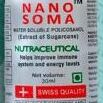Future-Forward: The Promise of Nanosoma in Modern Medicine and Beyond
In the rapidly evolving landscape of modern medicine, researchers and innovators continuously seek groundbreaking solutions to enhance human health and well-being. Among the emerging technologies capturing the attention of the scientific community and healthcare practitioners is Nanosoma, a revolutionary compound that heralds a new era in medicinal therapies. With its unique properties and potential applications, Nanosoma exemplifies the intersection of nanotechnology and medicine, offering hope for treating a wide range of diseases and conditions.
Understanding Nanosoma
Nanosoma is derived from natural sources, particularly from plant extracts, and is characterized by its nano-sized particles that facilitate enhanced absorption and bioavailability. Its primary mechanism of action is rooted in the modulation of immune responses, making it a powerful agent in combating various health issues. By leveraging its size, Nanosoma can penetrate cellular membranes more effectively than larger molecules, thereby optimizing the delivery of therapeutic agents.
Researchers suggest that Nanosoma’s ability to interact with the body’s cellular structures can lead to significant advancements in the treatment of chronic illnesses, autoimmune diseases, and even cancer. Its multi-faceted approach to healing positions it as an essential player in integrated medicine—an evolving field that emphasizes the use of multiple modalities and agents to foster health and recovery.
The Mechanism of Action
The power of Nanosoma lies in its ability to promote homeostasis and cellular repair. It appears to activate the body’s innate healing mechanisms, including immune modulation, tissue regeneration, and antioxidant effects. By encouraging optimal cellular function, Nanosoma helps the body resist disease and recover more efficiently from injuries and illnesses.
Recent studies indicate that Nanosoma can reduce inflammation, enhance cellular communication, and improve metabolic functions. This positions it as a holistic health solution, fostering not just recovery from disease, but also bolstering overall wellness—a concept that resonates deeply with patients and healthcare providers alike.
Potential Applications in Medicine
-
Autoimmune Diseases: Nanosoma’s immunomodulatory properties present a promising avenue for alleviating conditions such as rheumatoid arthritis, lupus, and multiple sclerosis. By modulating the immune response, Nanosoma could promote tolerance to self-antigens and reduce disease progression.
-
Infection Control: With the rise of antibiotic-resistant bacteria, the search for alternative therapies is more pressing than ever. Nanosoma may offer a novel approach to enhancing the efficacy of existing antimicrobial agents, potentially reducing the duration of infections and improving patient outcomes.
-
Chronic Illness Management: For individuals suffering from chronic conditions like diabetes or cardiovascular diseases, Nanosoma could assist in maintaining metabolic balance and improving quality of life through its reparative capabilities.
-
Neuroprotective Effects: Preliminary research suggests that Nanosoma may hold potential in neuroregenerative medicine, offering hope for conditions like Alzheimer’s and Parkinson’s diseases by promoting neuronal health and longevity.
- Cancer Therapy: Nanosoma’s ability to target and modulate cellular processes opens the door to innovative cancer treatments that could complement traditional chemotherapy and radiotherapy, potentially enhancing their effectiveness while minimizing harmful side effects.
Beyond Medicine: A Holistic Perspective
The promise of Nanosoma extends beyond its medical applications. As societies increasingly recognize the interconnectedness of physical and mental health, Nanosoma aligns with holistic practices aimed at promoting comprehensive well-being. Its potential to facilitate healing on multiple levels advocates for a more integrative approach, one that embraces not just the absence of illness but the presence of robust health.
Moreover, the sustainable integration of Nanosoma into healthcare systems could revolutionize treatment pathways, offering economically feasible options in resource-constrained settings. Its reliance on natural compounds also reflects a growing trend towards environmentally sustainable practices in pharma, contributing to a greener healthcare industry.
Conclusion: A Future of Possibilities
As research continues to unravel the complexities of Nanosoma, its future in modern medicine looks promising. This innovative compound represents not only a pivotal tool in combating disease but also embodies a shift towards a more comprehensive understanding of health and wellness. Through its unique properties, Nanosoma is poised to become an integral part of the healthcare paradigm, enabling patients to reclaim their health in a sustainable, holistic manner.
The journey of Nanosoma is still unfolding, and while challenges remain in terms of regulatory approval and widespread acceptance, the overarching narrative is one of hope and potential. In embracing such innovations, the medical community takes a significant step forward—towards a future where healing is more than a treatment; it is a pathway to thriving in harmony with nature and technology.
